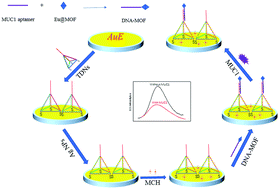A silver nanoparticle-assisted signal amplification electrochemiluminescence biosensor for highly sensitive detection of mucin 1†
Abstract
A novel electrochemiluminescence (ECL) biosensor was developed in this study, which was based on the Ag-NP modified tetrahedral DNA nanostructure. First, a stable and rigid three-dimensional tetrahedral DNA nanostructure (TDN) was modified on a gold electrode, which was used as a capture element. The TDN improves the accuracy and sensitivity of this biosensor. In addition, silver nanoparticles (Ag NPs) with excellent electrical conductivity were introduced on the edges of TDNs to enhance the ECL intensity of the metal–organic framework (MOF) nanomaterial. Apart from imparting conductivity, the Ag NPs can also act as co-reactant accelerators to enhance the ECL intensity. A Eu3+ doped Zr-MOF material (Eu@MOF) was proposed and used as an ECL material for the first time. Terminal phosphate-modified MUC1 aptamer DNA bonded with the exposed Zr nodes on the surface of MOFs through Zr–O–P bonds to construct the DNA–Eu@MOF signal element. Based on the Ag NP-modified TDN capture element and the DNA–Eu@MOF signal element, a hypersensitive biosensor was established. Under the optimal conditions, this biosensor exhibited a wide detection range from 1.135 fg mL−1 to 0.1135 ng mL−1 and a low detection limit of 0.37 fg mL−1 (S/N = 3) toward the target MUC1. The biosensor also showed excellent stability and high selectivity for MUC1 detection.



 Please wait while we load your content...
Please wait while we load your content...